Gaming Performance Continued
Ghost Recon Breakpoint DX12
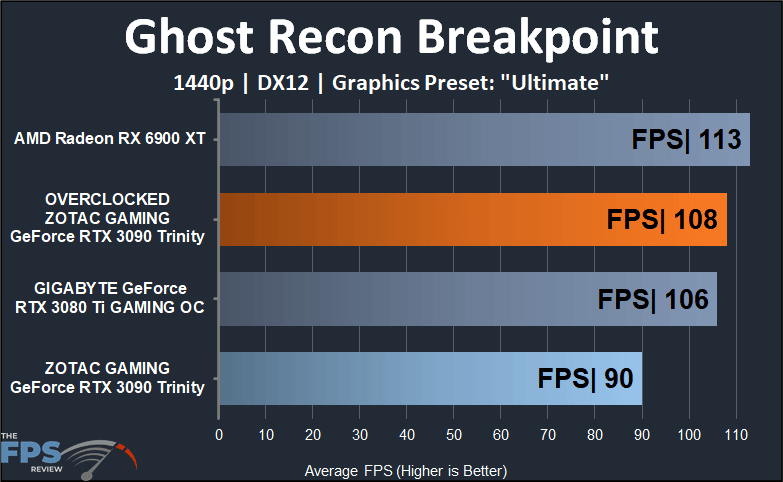
In the past, we’ve usually tested Ghost Recon Breakpoint with the Vulkan renderer which often showed upwards of a 20% uplift in performance. However, over the past year, there have been many performance issues and visual anomalies with the Vulkan renderer. As a result, we are testing with DX12. DX12 performance has come a long way with this game and it’s roughly as fast as it used to be in Vulkan.
All that said, the game doesn’t have DLSS or ray tracing support. We are running on the “Ultimate” preset which goes beyond what hardware was capable of doing when the game initially launched. As you can see, our ZOTAC Gaming GeForce RTX 3090 Trinity scores a result of 90FPS. The GIGABYTE RTX 3080 Ti Gaming OC is quite a bit faster here with a result of 106FPS. When overclocked the ZOTAC Gaming GeForce RTX 3090 Trinity is even faster at 108 frames per second.
The surprise here is AMD’s 6900XT scoring a result of 113FPS. However, that could be due to the CPU differences. I am not sure.

Despite its age, Ghost Recon Breakpoint is a rather demanding game. Our ZOTAC Gaming GeForce RTX 3090 Trinity is only capable of delivering 56FPS in this test. The GIGABYTE RTX 3080 Ti Gaming OC is significantly faster than the base RTX 3090 at 68FPS. A 12FPS difference. However, when overclocked the ZOTAC Gaming GeForce RTX 3090 Trinity has huge gains coming in at 71FPS. A 15FPS difference. The Radeon 6900XT achieves the best performance here at 73FPS.
It is possible that the 5800X is responsible for this difference, but at 4K, the CPU generally matters very little. Either way, these cards all show very similar capability in this game albeit, a base RTX 3090 certainly benefits from tuning.
Far Cry 6
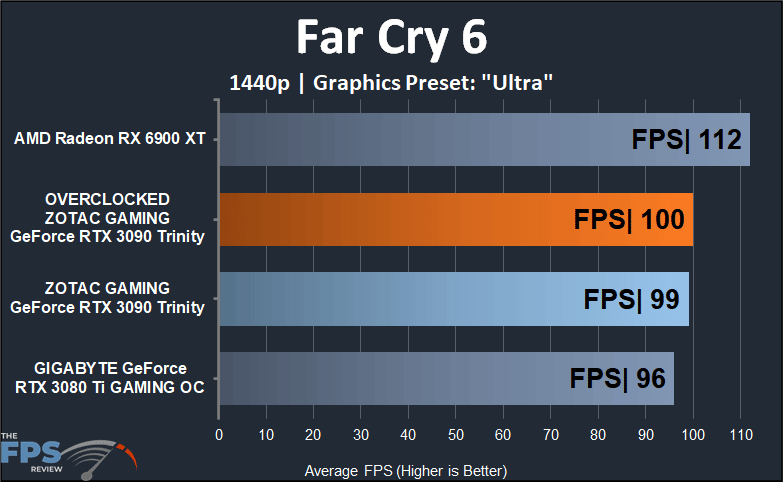
In this test, the Radeon RX 6900XT is a monster with a result of 112FPS. Strangely, the RTX 3080 Ti was slightly slower than our ZOTAC Gaming GeForce RTX 3090 Trinity for some unknown reason. Overclocked, we saw a very little gain in this test with an increase of 1FPS which is frankly something you could see as run to run variation.
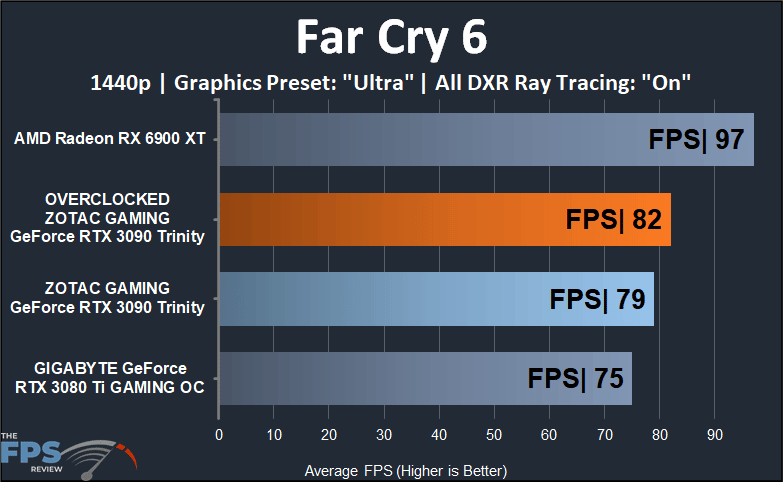
In this test, we see a result of 75FPS from the GIGABYTE RTX 3080 Ti and 79FPS from the ZOTAC Gaming GeForce RTX 3090 Trinity. When overclocked, we saw a slight gain of 3FPS for a total of 82FPS. However, the Radeon RX 6900XT trounced our NVIDIA results once again at 97FPS. Again, this isn’t an entirely GPU-limited resolution and that setup is running a faster CPU for what it’s worth.

In the 4K test, the ZOTAC Gaming GeForce RTX 3090 Trinity achieves 79FPS, which is 2FPS higher than our GIGABYTE RTX 3080 Ti Gaming OC card and 4FPS under the AMD RX 6900XT. However, when overclocked the ZOTAC Gaming GeForce RTX 3090 Trinity shows substantial gains coming in at 92FPS. Being largely GPU limited at this resolution, it’s not entirely surprising.
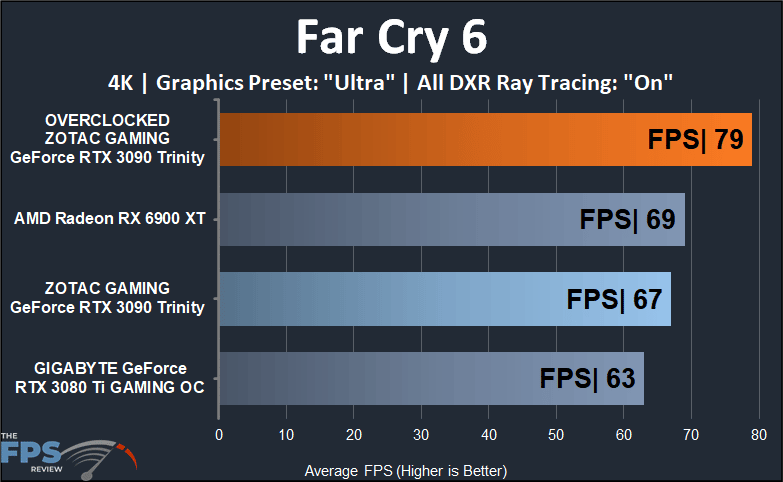
At 4K with ray tracing, it’s shocking how well the 6900XT does here with a result of 69FPS. At stock speeds the ZOTAC Gaming GeForce RTX 3090 Trinity achieves a result that’s slightly behind our AMD result at 67FPS. Strangely, the RTX 3080 Ti falls a bit behind in this title falling 4FPS behind the ZOTAC Gaming GeForce RTX 3090 Trinity at stock speeds.
When overclocked, the ZOTAC Gaming GeForce RTX 3090 Trinity shows significant gains once more achieving more than a 10FPS uplift in performance. The most surprising thing is that AMD kept up at all here given the difference in ray tracing performance we normally see between them.
Shadow of the Tomb Raider
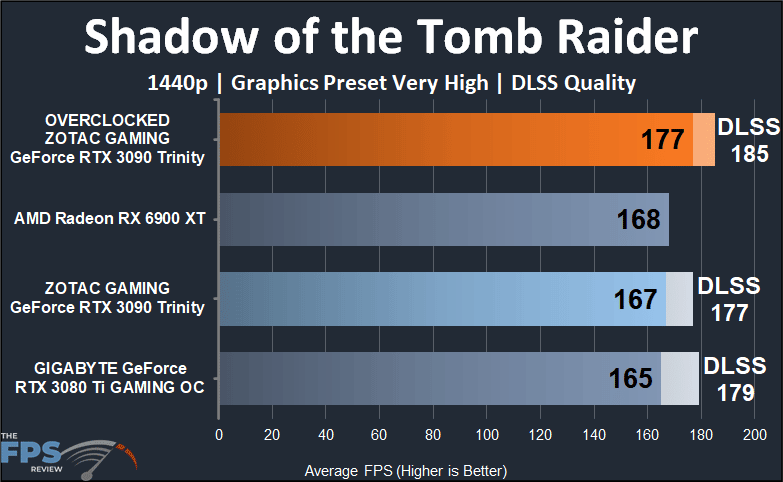
Shadow of the Tomb Raider is a couple of years old but it does support ray tracing and NVIDIA’s DLSS implementation. Here we see broadly similar results out of all of our test GPU’s here. The ZOTAC Gaming GeForce RTX 3090 Trinity produced a result of 167FPS without DLSS and 177FPS with DLSS enabled. When overclocked, we saw a 10FPS increase from 167 to 177FPS without DLSS and 177 to 185FPS with DLSS enabled. Our AMD RX 6900XT doesn’t support DLSS, but managed a result of 168FPS, which was 1FPS higher than our RTX 3090 at stock speeds and the RTX 3080 Ti OC scoring 167 and 165FPS respectively.
At these settings, any of these GPUs provide excellent performance, and given that most 1440P displays have a 144Hz or 165Hz refresh rate, this performance is right in line with that.

With ray tracing enabled, with and without DLSS, we saw considerably lower but very playable numbers from our test GPU’s. The ZOTAC Gaming GeForce RTX 3090 Trinity achieved a result of 105FPS without DLSS and 120FPS with DLSS enabled at the quality setting. Our RX 6900XT was slightly slower at 95FPS. In contrast, the RTX 3080 Ti OC was slightly faster than the stock ZOTAC Gaming GeForce RTX 3090 Trinity coming in at the same 105FPS without DLSS and a slightly higher 124FPS with DLSS set to quality.
When overclocked, the ZOTAC Gaming GeForce RTX 3090 Trinity saw a slight uplift in performance to 109FPS without DLSS and 129FPS with DLSS enabled. Again, all of these GPUs are capable of providing a superb gaming experience in this title using these settings.
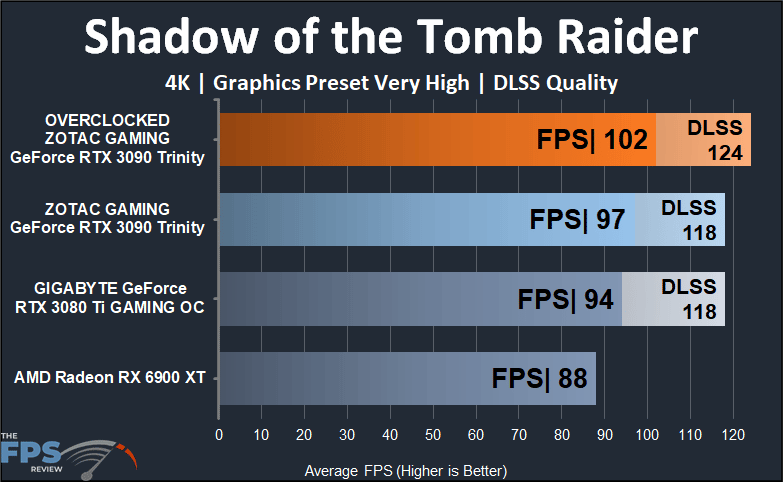
At 4K, with and without DLSS we saw naturally reduced performance compared to 1440P. However, the numbers still indicate a more than playable experience with impressive results at this demanding resolution. The ZOTAC Gaming GeForce RTX 3090 Trinity gave us 97FPS at 4K without DLSS and 118FPS with DLSS set to quality. This edged out our RTX 3080 Ti OC by 3FPS without DLSS and with DLSS enabled, it had an identical performance with 118FPS.
When overclocked, the ZOTAC Gaming GeForce RTX 3090 Trinity achieved 5 more FPS than it did at stock settings without DLSS and 124FPS with DLSS enabled compared to the 118FPS at stock speeds. Finally, the AMD RX 6900XT falls well short here at 88FPS. Naturally, it doesn’t have the luxury of DLSS or an equivalent in this game.

In this test, our ZOTAC Gaming GeForce RTX 3090 Trinity achieved a result of 59FPS without DLSS enabled and 83FPS with DLSS enabled. This was exactly 1FPS behind the GIGABYTE RTX 3080 Ti Gaming OC’s result of 60FPS and 84FPS respectively. The RX 6900XT turned in a score of 51FPS. When overclocking, we saw an increase to 62FPS compared to the stock result of 59FPS without DLSS enabled. With DLSS enabled, the performance increased to 86FPS.
